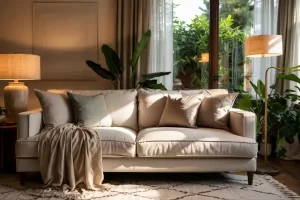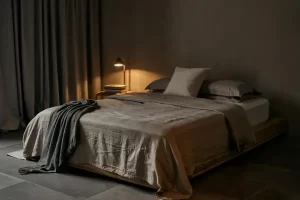Lighting plays a pivotal role in interior design, far beyond just making a room visible. The right lighting can influence mood, highlight architectural features, and enhance the emotional atmosphere of a space. In particular, mood lighting—the strategic placement of lamps, fixtures, and light tones—can transform an ordinary room into a warm, calming, or even energizing environment. Whether you’re designing a cozy reading nook, a romantic dining area, or a productive home office, mas…
This article explores creative ways to use lamps, light placement, and intensity to shape ambience in your home. From layering light sources to choosing the best bulbs, you’ll learn how to design interiors that feel inviting and emotionally resonant, no matter the time of day.
Understanding the Layers of Light
Effective mood lighting relies on the use of layered lighting. Instead of relying solely on overhead lights, you create a more flexible and inviting atmosphere by combining three layers of light: ambient, task, and accent. Each plays a different role and contributes to a richer, more dynamic space.
Ambient Lighting: The Base Layer
Ambient lighting provides general illumination and sets the foundation for the room. It often comes from ceiling-mounted fixtures, recessed lights, or large floor lamps. Though functional, ambient light alone can feel flat—so it’s important to layer it with other sources for a cozier feel.
Task Lighting: Precision and Function
Task lighting is focused and directional, designed for activities like reading, working, or cooking. Desk lamps, under-cabinet lighting, and adjustable arm lamps are all examples. These fixtures provide bright, localized light that enhances functionality without overwhelming the senses.
Accent Lighting: Depth and Emotion
Accent lighting adds visual interest and highlights focal points like artwork, architectural features, or textured walls. This layer is key to shaping mood and atmosphere, as it creates contrast and directs the eye. Think of spotlights, picture lights, or small table lamps that emit a soft glow.
Use Layered Lighting to Add Depth and Versatility
Layered lighting is the foundation of mood lighting. By combining different types of light sources—ambient, task, and accent—you can adjust the atmosphere of a room depending on the occasion or time of day. It gives you full control over how the space feels and functions.
Ambient Lighting for General Illumination
Ambient lighting is your room’s primary source of light. It ensures that the entire space is evenly lit. Use ceiling-mounted fixtures like flush mounts, chandeliers, or recessed lighting to establish a base level of brightness. For mood lighting, choose dimmable options or fixtures with warm bulbs to soften the intensity.
Task Lighting for Practicality and Focus
Task lighting serves a specific purpose, such as reading, cooking, or working. Desk lamps, pendant lights over kitchen islands, and bedside lamps all fall into this category. Choose directional lights or adjustable fixtures that reduce glare while offering enough illumination to be functional. For mood, opt for shades or frosted bulbs to diffuse the light.
Accent Lighting to Highlight and Enhance
Accent lighting draws attention to certain features of the room—artwork, architectural details, plants, or textured walls. Wall sconces, uplights, or LED strips work well for this purpose. Use warmer color temperatures and position the lights at angles that create soft shadows, adding drama and sophistication to the space.
Make Strategic Use of Lamp Types
Lamps are not just functional—they are key design elements that influence the room’s ambiance. Each type of lamp offers a unique opportunity to manipulate mood and visual style. Thoughtfully choosing and placing lamps can make a space feel cozy, energizing, romantic, or serene.
Table Lamps for Gentle Localized Light
Table lamps are perfect for adding intimate pools of light. Place them on nightstands, side tables, or consoles to provide warmth and a visual anchor. Choose lampshades that diffuse light softly and avoid harsh direct beams for a calming glow.
Floor Lamps for Vertical Drama
Floor lamps are excellent for filling corners or complementing seating areas. They can also add vertical interest and a sense of balance to your décor. Arched floor lamps work well over sofas or reading chairs, while tripod styles add a sculptural element to minimalist interiors.
Wall Lamps for Space-Saving Illumination
Wall-mounted lamps or sconces save surface space and provide targeted lighting. They are ideal in hallways, above bedside tables, or flanking mirrors in bathrooms. Choose models with adjustable arms to direct light where it’s most needed, and opt for soft LED bulbs to avoid harshness.
Consider Color Temperature and Bulb Choices
Color temperature plays a crucial role in setting the mood of a space. A warm white light (2700K–3000K) creates a cozy and inviting atmosphere, while cooler whites (4000K–5000K) are more energizing and suitable for work areas.
Smart bulbs allow you to change the color and intensity with your phone or voice commands. They are excellent for experimenting with mood settings—dim them for movie night, brighten them for a party, or switch to candle-like tones for a romantic dinner.
Position Lights Thoughtfully to Shape the Atmosphere
Where you place your lighting is just as important as the fixture itself. Strategic placement can help define zones, highlight focal points, and alter the perception of space. Avoid uniform lighting across a room—variation adds interest and emotion.
Light Up Corners for Depth
Dark corners can make a room feel smaller and less inviting. Use floor lamps or small spotlights to softly illuminate these areas. This creates a sense of openness and brings warmth to previously neglected spots.
Use Lighting to Define Zones
In open-plan homes, lighting can subtly distinguish functional areas. A pendant light over the dining table, a task lamp on the desk, and ambient lighting in the living space all help to organize the layout visually and emotionally.
Play with Shadows
Shadows add depth and texture to a room. Use light strategically to cast interesting shadows through objects like indoor plants, lattices, or decorative screens. This interplay of light and dark contributes to a more dynamic and layered environment.
Mix Lighting Styles to Match Your Decor Theme
Lighting doesn’t just illuminate—it communicates your style. Match lighting fixtures to your interior design to enhance aesthetic cohesion and express personality. Blend traditional with modern, rustic with sleek, or colorful with neutral depending on your desired vibe.
Rustic and Natural Spaces
Use wooden lamp bases, linen shades, and warm-toned bulbs to reinforce an organic, earthy feel. Lantern-style lights or candle-inspired sconces work beautifully in rustic or farmhouse interiors.
Modern and Minimalist Interiors
Opt for clean lines, monochrome finishes, and geometric shapes. Recessed lighting, LED strips, or ultra-slim pendant lights contribute to a clutter-free look while offering ample illumination.
Eclectic and Artistic Homes
Mix vintage lamps, sculptural pieces, and colorful bulbs. Think bold lampshades, unexpected placements, or lights that double as art. This is your chance to get playful and personal with your lighting choices.
Choosing the Right Bulbs for the Right Mood
The type of bulb you use can greatly influence the mood and functionality of your lighting. Bulbs come in various color temperatures, brightness levels, and energy efficiencies. Knowing which to choose for each purpose will elevate your design and atmosphere.
Warm White vs. Cool White
Warm white bulbs (around 2700K to 3000K) emit a soft, golden light ideal for cozy environments like bedrooms, living rooms, and dining areas. Cool white bulbs (4000K and up) produce a brighter, bluish tone suited for kitchens, bathrooms, and home offices where clarity is key.
Dimmable LED Bulbs
Opt for dimmable LED bulbs whenever possible. They are energy-efficient, long-lasting, and compatible with a wide range of fixtures. Pair them with dimmer switches or smart systems to customize brightness throughout the day.
Colored Lighting for Accent and Mood
Smart bulbs that shift colors or RGB strips can be used to create fun, dramatic, or serene atmospheres. Use soft pink or amber for a romantic setting, blue for calm, or green for a touch of nature-inspired tranquility.
Final Thoughts: Let Lighting Tell Your Story
Lighting is one of the most expressive and transformative tools in interior design. It not only determines visibility but also influences emotions, energy, and the way people interact within a space. By mastering the placement of lamps, selecting the right types of lighting, layering illumination, and matching light to decor and purpose, you can create an ambiance that is both functional and deeply personal.
Experiment with different setups, adjust according to the time of day, and don’t hesitate to incorporate smart lighting solutions to gain full control over your atmosphere. With thoughtful planning and creative choices, your home can glow with the perfect mood lighting for any moment—from peaceful evenings to lively social gatherings.




